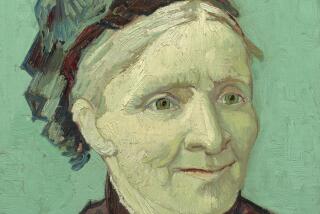Vietnam Artist Finds Inspiration and a Living Copying Masters
- Share via
HO CHI MINH CITY, Vietnam — Even when he came south as a soldier with the North Vietnamese army, Ngo Dong carried a sketch pad. During lulls in the battle, he would draw pictures of flowers and rice paddies and dream of being a great artist.
However, life was unimaginably hard after the Vietnam War ended in 1975, and no one could survive as an artist. Dong got a job painting store signs by day. By night he painted for his own pleasure in the humble apartment he shared with three generations of his family.
Not until Vietnam started moving toward a free-market economy with its 1986 policy known as doi moi did Dong’s life take a turn for the better. The arts began to flourish, and now the 45-year-old painter is part of a booming business in this city once known as Saigon: the reproduction of the works of the great Western and Russian masters.
In his little studio on Pasteur Avenue--one of two streets in Ho Chi Minh City whose French name survived the Communist takeover--Dong is copying one of his favorite masterpieces, “The Major’s Marriage Report” by the 19th century Russian artist Pavel A. Fedotov. The reproduction will take him a week and earn him about $75 from his client, a Vietnamese businessman.
“You could say this is not real art,” said Dong, regarded as one of this city’s top reproduction artists, “but I like my work. I get inspiration for my own painting while I’m doing it, and I think I’m helping the Vietnamese to appreciate the great painters.”
In dozens of small, street-level studios throughout the city, artists sit side by side and turn out assembly-line Monets, Van Goghs, Manets.
Some of the reproductions are very good, art critics say. Most clients are Vietnamese, although the works also are bought by foreigners. An Italian recently commissioned 30 reproductions of paintings by Fernando Botero, the Colombian artist.
Although copyrights are infringed in some cases, especially when paintings by living artists such as Botero are involved, Western diplomats said the reproductions are done with no criminal intent and do not end up in the international marketplace to be sold as originals. The paintings are not signed with the original painter’s name.
When Le Diep, 35, an accountant here, showed up in Dong’s studio recently looking for a present for a friend, the artist pulled out his catalog of great paintings. Diep thought about a Picasso before settling on a Monet.
Vietnam’s history of oil painting dates only to 1925, when its colonial ruler, France, established the Indochina Fine Arts Institute in Hanoi. Within a generation there was war with France, then the United States. Artists were pressed into duty as propagandists, painting posters and designing leaflets in the name of nationalism and communism.
The postwar period brought little relief.
If Dong had an idea for a painting, he first had to submit a sketch of his proposed work to the government. If it was approved, he would receive a canvas and packet of paints made in East Europe. The paint, he said, was so old, it often was rock hard and unusable.
All this started to change in the late 1980s. Political art began disappearing, and artists were no longer bound by rules that their art had to be pleasing to the government. Quality art supplies appeared in shops, and dozens of galleries opened.
Vietnam’s current original artwork abounds in landscapes and scenes of village life. It is vibrant and colorful, and lacks the anger and darkness one might expect to find in a country that suffered so much for so long.
And slowly, in an atmosphere of increased individual freedom, Vietnam is producing young, talented artists who have held exhibitions in New York and Hong Kong.
“I still dream of being a great artist,” said Dong, who is at his easel 10 hours a day, six days a week. “And I still save Sunday and nights to work on my own paintings, so it is not an impossible dream.”
More to Read
Sign up for Essential California
The most important California stories and recommendations in your inbox every morning.
You may occasionally receive promotional content from the Los Angeles Times.










